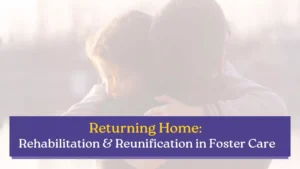“Anna* broke this,” our son said, holding a shattered ornament in his hand. I told him to do his best to clean it up and then ask Anna to come see my wife and me in our room.
Anna had been in our home only about an hour. Born in a country halfway around the world, she had come to the United States with her biological father a few months earlier. Not long after her arrival, she’d been placed with a family that had taught her how to speak English.
Unfortunately, this family had also shown Anna what conditional love looked like. They’d told her that if she didn’t behave properly, she would have to leave their home. Naturally, her humanity, her traumatic past and her age—she was only 6 at the time—made it impossible for her to meet their standards, and they had requested she be placed elsewhere.
Anna had come to our home in tears. She wasn’t crying because she missed the other family, but because children aren’t designed to experience this kind of rejection. I am sure the other family’s biological children had misbehaved plenty of times. The difference was that they didn’t fear rejection. They were part of the family. Anna wasn’t.
A few minutes after we sent our son to fetch Anna, she showed up in our doorway, petrified. Her eyes reflected her distress as she admitted breaking the ornament. Our hearts broke for her. We sensed she feared being rejected again.
We assured Anna there was nothing she could do that would cause us to make her leave. Upon hearing those words, she physically relaxed. We hugged her and then sent her on her way to get to know her new siblings.
God used a broken ornament to help us make our new daughter feel valued and welcome. She needed to see she was not an intruder but a member of the family. Eventually we adopted her. And she’s been a part of the family for the past 15 years.
Whenever a new child is placed in a home through foster care or adoption, he or she needs to feel safe, welcome and part of the family, especially if that child has experienced trauma. Here are ways other parents have welcomed children into their homes:
Unrushed, Day by Day
As adoptive parents through foster care, my husband and I strived to create a calm environment for our children. I had to learn to take panic-filled kids in my arms until they felt connected and safe. Time stood still as we rocked together. I waited with them for as long as it took. I told them it was OK to cry, and sometimes they did. Other times we sat in silence.
As I helped my children identify their feelings, repeating what I heard, their countenances brightened. Whether they were feeling scared, worried, nervous, alone or hungry, responding to them with understanding gave voice to their feelings of undiscovered or buried pain. As I created a safe place where trusting me was possible, they learned that my love was genuine.
I’ve realized that my children don’t need me to save them from all their past traumas or fears. They need me to walk with them, unrushed, day by day. Doing that affirms their place in my world.
—Kelly D. McManus
The Gift of Space
What my young ones need most is space. Space to process. Space to feel. Sometimes they just need my husband and me to ignore the stares and comments that show up when they can’t hold themselves together any longer.
Some of the emotions they’ve held inside are more powerful than many adults will ever face. Regardless of the pain they’ve already endured, being taken from one family and placed with another is traumatic—even if it someday leads to healing, even if it assures safety, even if their lives improve.
It’s not uncommon to find me sitting in the middle of a grocery aisle holding my boy when the experience is just too much for him. Christmas sometimes means ignoring the new toys for a day or so until he is ready to play with them. At a large dinner with extended family, it might mean that we excuse him from the table and let him sit quietly in the next room. On vacations, it means keeping his routine as close to normal as possible. We teach manners on quiet, normal days and expect less of him on special occasions.
No matter how much better things may seem, children still have memories and questions about their lives before. Every tradition feels new: the foods, smells, voices, routines, love. So as parents, we show them that no matter how overwhelmed they feel, they are loved.
—Shandy Hodsdon
Embrace Humility
One of the best things my husband and I did to prepare for opening our hearts and our home to foster children was not being afraid of the messes of life. We never expect perfection or instant results. Every day we remind our kids that they are safe, valued, loved and a vital part of our family. This is harder than it sounds because kids in foster care have had too many rugs ripped from beneath them. Every day we reassure our children that we can do hard things together, that because of God we hope big, and we believe the pain and fear of uncertainty won’t always plague them.
We also try to model a healthy marriage and demonstrate humility. Indeed, we notice less fear among our children when we show them that while married life has bumps and misunderstandings, a husband and wife can still come together in love no matter what. My husband and I humble ourselves in front of the kids, apologizing to each other and making up where they can see us. We try to treat them the same way, asking for forgiveness when we fail.
Our children need to see disagreements that don’t end in abuse or unsafe behavior. Allowing kids into the process of working through conflict, hurt feelings and differing perspectives builds reassurance and trust. And the best way to demonstrate that is to never hold back on love.
—Kara N. Young
Honoring Memories
We learned early on in foster parenting to treat every child who came into our home, whether for days or months, the same way we treat all of our children. For example, if you never buy used clothes for your children, don’t do that for foster children.
I also learned to make a memory life book for every child who lives with us, documenting the child’s history and time with our family. So many children who spend time in foster care lose track of those years. No mementos, no photos, no memories. If we are called to love and care for these children, that includes helping them preserve their past.
We adopted our fourth and fifth foster placements. When they were with us only a few months, they were diagnosed with fetal alcohol syndrome and some developmental delays. I was angry. How could anyone do that to a baby? How unfair! Sessions with a therapist and lots of prayer helped me work through forgiving their mother. Eventually she and I became friends, and today we share the children we both love.
I’ve also learned to listen. My children shut down if I talk too much. Sometimes it’s just a matter of extending grace and unconditional love. It isn’t always easy, but it’s exactly what God does for us.
—Tricia Couffer
Preparing Your Welcome
Be intentional about creating a welcoming environment for a new child in your family:
- Establish and maintain routines that are unique to your family. When a new child arrives, include him or her in those routines right away. That will make him or her feel like an insider more quickly and will create a sense of belonging.
- Talk to your children about things they can do to make your new child feel welcome, such as sharing toys, picking out movies and TV shows to watch together and introducing him or her to friends. Make sure your children do not see this as something imposed on them by Mom and Dad (which they will possibly grow to resent), but rather something the whole family is doing for the benefit of the new child and in obedience to God’s call to love our neighbors as ourselves.
- Talk to your parents, siblings, extended family and close friends in advance and ask them to treat this child the same way they do your other children.
- If possible, talk to the child’s social worker before the placement is finalized. Find out what your child likes (food, restaurants, clothes, music, etc.), and then try to accommodate as you’re able.
- Give your new child chores, just as you do with your other children. That will help him or her take responsibility for being part of your household.
- As you’re able, build relationships with your child’s siblings and extended family, treating them as part of your extended family. The child needs you to adopt an “us” mindset rather than an “us and them” mindset.
- Honor your child’s birth parents by speaking of them in respectful terms. Exhibit grace and compassion. Do not vilify them. At the same time, give the child freedom and a listening ear to process his or her feelings honestly and openly, without judgment from you.
- Introduce your new child by name to your friends, neighbors, family, church family and others in your life. Be careful not to saddle your child with the foster label.
Children placed in your home for foster care and adoption have often experienced considerable trauma and great loss. Their lives have been upended, and they often feel unworthy of love. They may think they are one wrong move away from another rejection.
If they are to heal from their trauma and loss, they need to feel safe, secure, accepted, wanted, valued, treasured and loved. They want to feel just as we do in our relationship with our heavenly Father, who adopted and welcomed us into His family. Your demonstration of love can point them to Him.
*Not her real name















